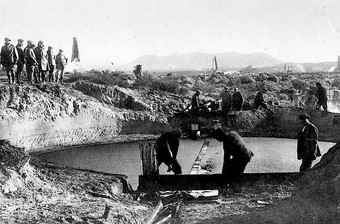36.2: Argentina
36.2.1: Argentina Before the Great Depression
Argentina, a non-industrialized country, experienced recession after World War I and before the global depression hit, but unlike neighboring countries, maintained relatively healthy growth rates throughout the 1920s.
Learning Objective
Describe Argentina’s economic status before the global depression hit.
Key Points
- Argentina was not an industrialized country in the lead-up to the Great Depression and lacked the energy sources necessary to make it so.
- One of Argentina’s most lucrative industries was agriculture, and its exports of frozen beef, especially to Great Britain, proved highly profitable.
- Argentina, like many other countries, entered a recession after the beginning of World War I as the international flow of goods, capital, and labor declined.
- Foreign investment in Argentina came to a complete standstill from which the country never fully recovered.
- Nonetheless, Argentina maintained relatively healthy growth throughout the 1920s, unlike neighboring countries, because it was relatively unaffected by the worldwide collapse on commodity prices. However, the global depression would eventually halt economic expansion within the country.
Key Term
- Southern Cone
- A geographic region composed of the southernmost areas of South America, south of and around the Tropic of Capricorn. Traditionally, it is comprised of Argentina, Chile, and Uruguay. It is bounded on the west by the Pacific Ocean and to the south by the junction between the Pacific and Atlantic Oceans.
Argentina was not an industrialized country by the standards of Britain, Germany, or the United States in the lead-up to the Great Depression, and lacked energy sources such as coal or hydropower to make it so. Experiments in oil extraction during the early 20th century had poor results. Yacimientos Petroliferos Fiscales (YPF), the first state-owned oil company in Latin America, was founded in 1922 as a public company responsible for 51% of oil production, with the remaining 49% in the hands of private concerns. Moreover, one of Argentina’s most lucrative industries was agriculture, and its exports of frozen beef, especially to Great Britain, proved highly profitable following the invention of refrigerated ships in the 1870s.

YPF workers (1923): YPF workers are shown working on an oil well in 1923.
Argentina, like many other countries, entered a recession following the beginning of World War I as the international flow of goods, capital, and labor declined. Additionally, following the opening of the Panama Canal in 1914, Argentina and other Southern Cone economies declined as investors turned their sights to Asia and the Caribbean. Even beef exports took a hit as Britain imposed new restrictions on meat imports in the late 1920s. Argentinian ranchers responded by switching from pastoral to arable production, but lasting damage had already been done to the Argentine economy. The United States viewed Argentina, and to a lesser extent Brazil, as a potential rival on the world markets, making collaboration less likely between the two countries. In light of the United States’ emergence from WWI as a political and financial superpower, this would prove particularly harmful to Argentina.
Meanwhile, foreign investment into Argentina came to a complete standstill from which the country never fully recovered. As a result, investable funds became concentrated over time at a single institution: the Banco de la Nacion Argentina (BNA). This made Argentina’s financial system vulnerable to rent-seeking. Re-discounting and non-performing loans grew steadily at the BNA after 1914 as a result of crony loans to other banks and the private sector, polluting the bank’s balance sheet. The state bank allowed private banks to shed their risks, using money not backed by collateral as security, then lent the private banks cash at a rate of 4.5%, below the rate the BNA offered to its customers on certificates of deposit. Ultimately, neither the Buenos Aires Stock Exchange nor any of the private domestic banks within the country would develop rapidly enough to fully replace the loss of foreign capital, the bulk of which was sourced from now heavily indebted Great Britain.
Nonetheless, Argentina maintained relatively healthy growth throughout the 1920s, unlike neighboring countries like Brazil and Chile, because it was relatively unaffected by the worldwide collapse on commodity prices. Similarly, unlike many European countries that abandoned it, the gold standard was still in place in Argentina during this time, contributing to the country’s relative financial stability. Automobile ownership in the country at 1929 was the highest in the Southern hemisphere, an indicator of the healthy purchasing power of the middle class on the eve of the Great Depression. However, the economic downturn would eventually halt economic expansion within the country.
Attributions
- Argentina Before the Great Depression
-
“Economic history of Argentina: 1914-1929.” https://en.wikipedia.org/wiki/Economic_history_of_Argentina#1914.E2.80.931929. Wikipedia CC BY-SA 3.0.
-
“YPF_workers_working_on_well_1282C_1923.jpg.” https://commons.wikimedia.org/wiki/File:YPF_workers_working_on_well_128,_1923.jpg. Wikimedia Commons Public domain.
-
Candela Citations
- Boundless World History. Authored by: Boundless. Located at: https://courses.lumenlearning.com/boundless-worldhistory/. License: CC BY: Attribution